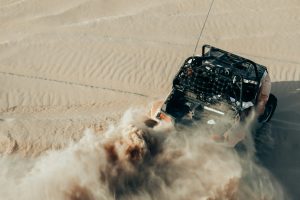Engineering AI solutions that survive the toughest environments
Deploying AI at the tactical edge isn’t just about performance—it’s about survivability. Military operations take place in extreme environments, where electronics are exposed to intense heat, shock, vibration, and dust. AI-powered systems must not only function in these conditions but do so without failure.
While COTS computing systems may be powerful in controlled settings, they often fall short in military environments. That’s why ruggedization isn’t an afterthought—it’s a fundamental requirement.
Why COTS solutions fail at the edge
Many AI systems are developed in research labs, where engineers focus on performance optimization, not environmental resilience. However, in real-world deployments, unpredictable conditions can quickly degrade or destroy non-ruggedized hardware.

Common failure points for non-rugged AI systems include:
- Overheating – AI workloads generate significant heat, and without proper thermal management, systems can throttle performance or shut down entirely.
- Shock and vibration damage – Military vehicles, aircraft, and ships expose electronics to continuous movement and impact.
- Moisture and dust infiltration – Unsealed components can suffer corrosion or short circuits.
“Agencies will come to us and have a lab development system, or a lab-based unit, that is functional, but now they want to take it to the next level and get it ready to survive at the edge,” said Morgan Uridil, advanced program pursuits manager at Crystal Group.
How Crystal Group ensures AI thrives in extreme conditions
At Crystal Group, ruggedization is engineered from the ground up, ensuring AI-powered systems remain operational in the most demanding defense environments. Our approach includes:
- Advanced thermal management – We design custom cooling solutions, including liquid cooling, heat sinks, and airflow optimization, to prevent overheating.
- Shock and vibration resistance – Our systems undergo MIL-STD-810 and MIL-S-901 testing, ensuring they withstand rough handling, transport, and deployment.
- Sealed, ruggedized enclosures – IP67-rated systems protect against moisture, dust, and debris, ensuring continuous operation in any climate.
- Built-in redundancy and fault tolerance – Auto-recovery systems, RAM parity, and self-healing components prevent mission-critical failures.
“Crystal Group is on the forefront of design, so that we can say, ‘When you go here, please be careful, because when we apply it in this kind of environment, a single event neutron upset can cause a RAM bit to flip,’” said Todd Prouty, senior business development manager at Crystal Group. “You need parity in your RAM so that they can self-correct that as it’s reading and not shut itself down.”
Bridging cutting-edge AI and real-world deployment
Crystal Group works closely with Intel® to integrate the latest AI capabilities into defense-ready solutions. While Intel focuses on next-generation AI processing, Crystal Group ensures those advancements are ready for real-world missions.
This partnership means defense teams can deploy AI at the edge with confidence, knowing their systems are built to endure.